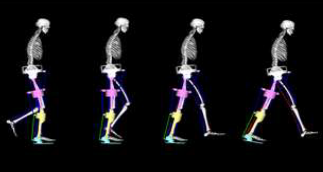Saving walking metabolic cost
Designed and modelled a walking assistance device to reduce the metabolic cost of human walking.
Reducing the metabolic cost of walking has long been a challenge for exoskeleton researchers. In a recent breakthrough, a passive exoskeleton was reported, which yielded significant energy saving with a clutch-spring mechanism working in parallel with calf muscles.
In this project, we investigate whether the same biomechanism exists in the hip and knee joints (Shen et al., 2018). We employed OpenSim, an open-source platform, and the MATLAB Optimization Toolbox to determine the engaging and disengaging timings and optimize the stiffness of the springs for walking energetic efficiency. When applied to the ankle joint, the proposed approach yielded results that agreed with the reported ones. We then extended this method to the hip and knee joints. The simulations showed that the springs could save up to 6.38%, 4.85%, and 7.63% for the ankle, knee, and hip joints at the optimal stiffness of 8.20 kN /m, 7.35 kN /m, and 4.15 kN/m, respectively.

